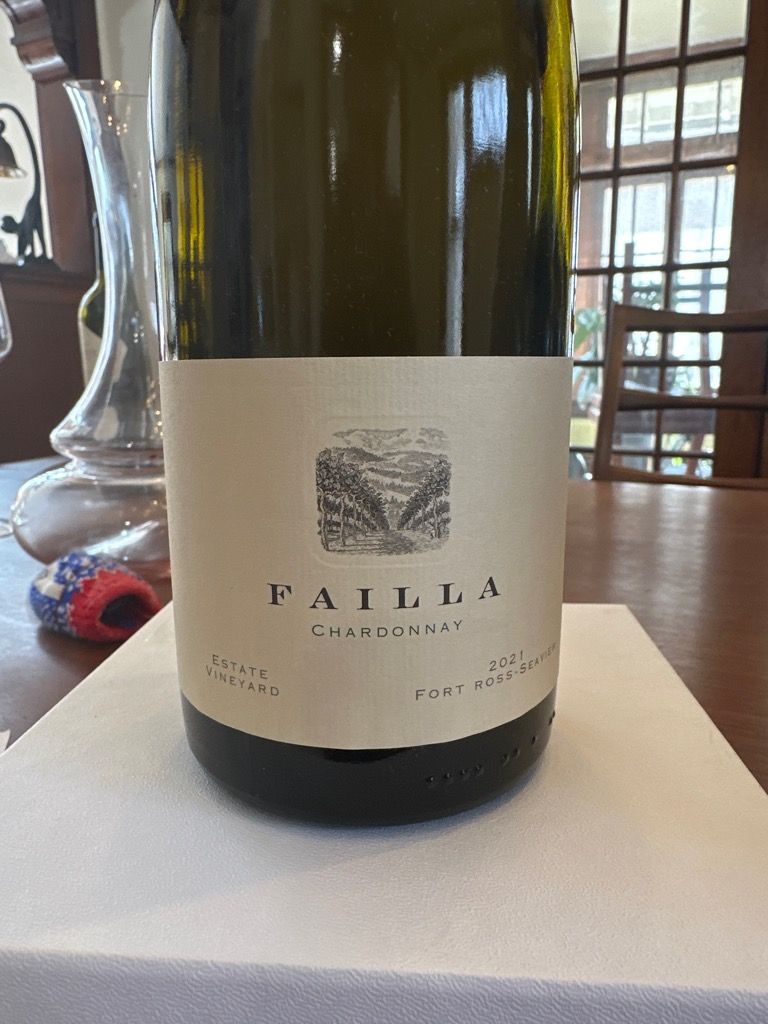
External search
Google (images)
Wine Advocate
Wine Spectator
Burghound
Wine-Searcher
Vintages
2022
2021
2020
2019
2018
2017
2016
2015
2014
2013
2012
2011
2010
2009
2008
2007
2006
2004
2003
2002
Show more
From this producer
Show all wines
All tasting notes
|
| Drinking Windows and Values |
| Drinking window: Drink between 2024 and 2029 (based on 29 user opinions) |
| Community Tasting History |
| Community Tasting Notes (average 91 pts. and median of 91 pts. in 2 notes) - hiding notes with no text | | | Tasted by Popoloinaz on 2/4/2024 & rated 91 points: Mellowed fruity taste. Quite yummy (171 views) |
| By Samantha Cole-Johnson
JancisRobinson.com (10/16/2023)
(Failla Chardonnay Fort Ross-Seaview White) Subscribe to see review text. | By Antonio Galloni
Vinous, Sonoma’s Sensational 2021s (Aug 2023) (8/1/2023)
(Failla Chardonnay Estate Vineyard Sonoma White) Subscribe to see review text. | By Audrey Frick
JebDunnuck.com, Sonoma’s 2021s (7/21/2023)
(Failla Chardonnay Estate Vineyard) Login and sign up and see review text. | By Antonio Galloni
Vinous, 2021 Sonoma Preview (Jan 2023) (1/1/2023)
(Failla Chardonnay Estate Vineyard Sonoma White) Subscribe to see review text. |
NOTE: Scores and reviews are the property of JancisRobinson.com and Vinous and JebDunnuck.com. (manage subscription channels) |
| Failla Producer websiteChardonnay The Chardonnay GrapeEstate VineyardFrom the Producer:
Coury Clone Block: In the spring of 2000 we took over the farming of what is now our Estate Vineyard from Autumn Wind Winery and Vineyard. Even though the purchase of the property and business would not occur until later that year we were entrusted with running the operation as if it were our own already. The vineyard was only around 22 acres at the time with a good deal of plantable land available. There were also areas that needed to be addressed. This block was one of those. This was originally planted in 1985. It is on a very steep facing at the apex of the vineyard’s hillside. The terraces that had been built to account for the hill’s grade were collapsing making tractor work hazardous. On top of that years of soil neglect had created an extremely untenable growing environment for the plants. We decided to tear this section out and start again. At this juncture Dijon clones were quite fashionable (not they are not now, just more so in an outsized sort of way back then) and since the vineyard was solely Pommard and Wadensvil we decided to plant Dijon 777. The decision never panned out. Despite having the Etzel Block to its west, the Wadensvil Block to the north and the Hallelujah Block (the largest portion of the Estate Old Vine) this block never produced wine anywhere near the quality of its neighbors. For 15+ years we saw harvests produce wines that usually were scheduled for our Willamette Valley bottling rather than something more unique and individual. While clonal makeup is not the defining character of terroir it is an aspect and in this case, we felt that aspect was holding things back. In the spring of 2019, we traded some vineyard management expertise for cuttings off our block of Coury Clone at Freedom Hill Vineyard. Given our success there and at Hyland Vineyard with this unique, Oregon-based clone we felt like we could maximize the setting. In one vintage, not counting the smoke taint-befouled 2020 vintage, we found that we were proven correct. More good things to come from this interesting part of our Estate!
Farming Practices: We have done the management of this property internally since we purchased it in 2000 with the exception of 2014 and 2015 when Sterling Fox’s management service did the work. Also, at that time, the vineyard was switched entirely to organic farming practices and remains so to this day. The vineyard has always been dry farmed.USAAmerican wine has been produced since the 1500s, with the first widespread production beginning in New Mexico in 1628. Today, wine production is undertaken in all fifty states, with California producing 84% of all U.S. wine. The continent of North America is home to several native species of grape, including Vitis labrusca, Vitis riparia, Vitis rotundifolia, and Vitis vulpina, but the wine-making industry is based almost entirely on the cultivation of the European Vitis vinifera, which was introduced by European settlers. With more than 1,100,000 acres (4,500 km2) under vine, the United States is the fourth-largest wine producing country in the world, after Italy, Spain, and France.California2021 vintage: "Unlike almost all other areas of the state, the Russian River Valley had higher than normal crops in 2021, which has made for a wine of greater generosity and fruit forwardness than some of its stablemates." - Morgan Twain-Peterson Sonoma CountyMendocino CountyFort Ross - SeaviewThe 27,500-acre Fort Ross-Seaview American viticultural area is located in the western part of Sonoma County, California contains 18 commercial vineyards on 506 acres, lies close to the Pacific Ocean and is about 65 miles north-northwest of San Francisco. It lies entirely within the Sonoma Coast viticultural area and does not overlap, or otherwise affect, any other viticultural areas.
Vineyards within this area are generally located on rounded ridges with summits extending above 1,200 feet consisting of steep, mountainous terrain made up of canyons, narrow valleys, ridges, and 800- to 1,800-foot peaks. Areas above 900 feet in elevation, the climate is influenced by longer periods of sunlight and is warmer than that in the surrounding land below.
The soils consist of Goldridge, Yorkville, Boomer, Sobrante, Laughlin, and many other soils within the Fort Ross-Seaview viticultural area. Hugo soils are common and are well drained, very gravelly loams derived from sandstone and shale
The most common varietals in the Fort Ross-Seaview AVA are Pinot Noir and Chardonnay. Other varietal are Pinotage, Zinfandel and Petite Sirah, Syrah, and small acreage of Viognier, Marsanne and Roussanne. |
|




